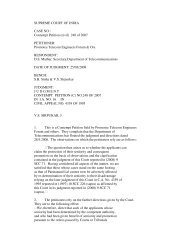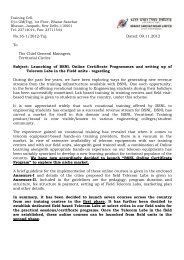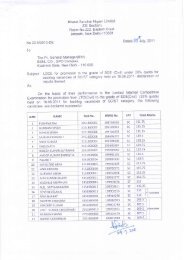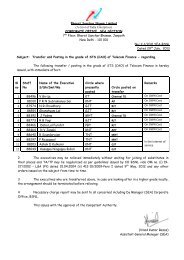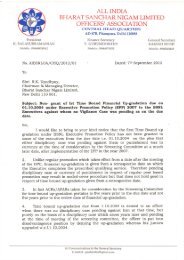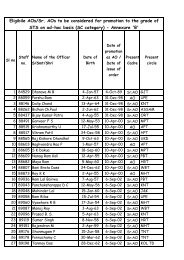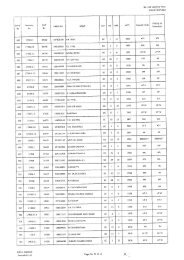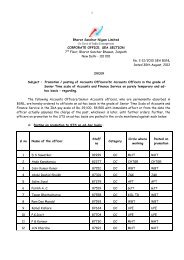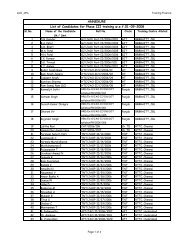DECISION OF DPE ON PAY SCALES OF EXECUTIVES IN CPSEs ...
DECISION OF DPE ON PAY SCALES OF EXECUTIVES IN CPSEs ...
DECISION OF DPE ON PAY SCALES OF EXECUTIVES IN CPSEs ...
Create successful ePaper yourself
Turn your PDF publications into a flip-book with our unique Google optimized e-Paper software.
<strong>DECISI<strong>ON</strong></strong> <strong>OF</strong> <strong>DPE</strong> <strong>ON</strong> <strong>PAY</strong> <strong>SCALES</strong> <strong>OF</strong> <strong>EXECUTIVES</strong> <strong>IN</strong> <strong>CPSEs</strong> vis-a-vis<br />
SEC<strong>ON</strong>D <strong>PAY</strong> REVISI<strong>ON</strong> COMMITTEE RECOMMENDATI<strong>ON</strong>S<br />
AN OBJECTIVE ANALYSIS<br />
The much awaited Government decision on the recommendations of 2 nd Pay<br />
revision Committee for the Executives and non-unionized Supervisors of the <strong>CPSEs</strong><br />
has since been announced. This has shattered the hopes of the Executives in all the<br />
<strong>CPSEs</strong> in general and BSNL in particular for better pay scales and other benefits. An<br />
analysis of outcome of these decisions makes certain interesting revelations.<br />
Categorization of <strong>CPSEs</strong>:<br />
The Government has not accepted the recommendation of the 2 nd Pay Revision<br />
Committee to have categorization of <strong>CPSEs</strong> in 5 categories viz. A+, A, B,.C,.D. Instead<br />
it has decided to continue with the existing categorization of <strong>CPSEs</strong> in 4 categories as<br />
A,B, C and D only.<br />
Pay Scales:<br />
The Government has not accepted the recommendation of the 2 nd Pay Revision<br />
Committee to have different pay scales for different category of the <strong>CPSEs</strong>. Further,<br />
the Government has ordered same pay scales for all categories of <strong>CPSEs</strong>, whereas the<br />
2 nd Pay Revision Committee had recommended higher pay scales for higher<br />
categorized <strong>CPSEs</strong>. Moreover, various revised pay scales from E-0 to E-7 for the<br />
Executives and non-unionized supervisors, as have been decided by the Government,<br />
are the lowest set of the pay scales that was recommended by the 2 nd Pay Revision<br />
Committee for D category <strong>CPSEs</strong>. In fact, the 2 nd Pay Revision Committee had<br />
recommended different set of revised pay scales in which the pay scales in C category<br />
<strong>CPSEs</strong> would have been higher than that in D category. Similarly, the pay scales in B<br />
category <strong>CPSEs</strong> would have been higher than that in C category, and so on. In the<br />
process, the Executives in A+ category <strong>CPSEs</strong> would have got the highest set of pay<br />
scales. But the Government has decided to have uniform pay scales for all categories<br />
of <strong>CPSEs</strong> and that too with the set of pay scales that was suggested by the 2 nd Pay<br />
Revision Committee for D category <strong>CPSEs</strong>. Thus the decision of the Government has<br />
adversely affected the Executives of all <strong>CPSEs</strong> in higher categories i.e. in C, B, A etc.<br />
The Executives in BSNL are now worst affected along with others who were expecting<br />
to be placed in A+ category <strong>CPSEs</strong> as recommended by 2 nd Pay Revision Committee<br />
and enjoy the highest set of pay scales.<br />
Fitment benefit:<br />
The 2 nd Pay Revision Committee had recommended a graded fitment benefit<br />
with varying percentage on the basic pay depending upon the scales and category of<br />
the concerned CPSE plus DA at 68.8 % allowing Executives of higher categorized<br />
<strong>CPSEs</strong> to get higher fitment benefit compared to the Executives in lower categorized<br />
<strong>CPSEs</strong> which even enabled the higher level Executives in the same CPSE to have
higher fitment benefit. But the Government has decided for application of uniform<br />
fitment formula of 30% on basic pay plus DA at 68.8% for all Executives in all the<br />
categories of <strong>CPSEs</strong>. Hence, though this decision will be a welcome step for lower<br />
categorized <strong>CPSEs</strong> i.e. B, C and D, it is a loss for the Executives in A category<br />
<strong>CPSEs</strong> like BSNL.<br />
As per the order issued by <strong>DPE</strong>, the fitment will now be uniform @ 30 % on<br />
basic pay plus DA at 68.8 % as on 01-01-2007. Now w.e.f. 01-01-2007, 50% of DA is<br />
merged with basic pay in most of the <strong>CPSEs</strong>. Thus on 01-01-2007, an executive was<br />
actually drawing his basic pay in the scale + 50 % D.P. + 18.8 % DA on pay plus DP.<br />
That is, they were drawing, in effect 9.4 % of pay more due to DA merger. But the 2 nd<br />
Pay Revision Committee did not consider the DA merger while suggesting fitment<br />
formula and had recommended graded fitment benefit of 30% of basic pay plus 68.8 %<br />
DA only. And this fitment benefit recommended by 2 nd Pay Revision Committee has<br />
been accepted by the Government without any improvement.<br />
It is worth mentioning here that the 6 th Central Pay Commission also<br />
recommended a fitment benefit on basic pay plus 74 % DA on 01-01-2006 for all<br />
Central Government Employees and did not take into consideration the DA merger<br />
for fitment. It had even reasoned against taking the DA merger for fitment. But the<br />
Government improved over the recommendation of the 6 th Central Pay Commission<br />
for Central Government Employees in respect of fitment formula. It took the DA<br />
merger into consideration and allowed a multiplying factor of 1.86 as against the<br />
multiplying factor of 1.74 recommended by the 6 th CPC and also added the ‘grade<br />
pay’ which was 40 % of maximum of the pay band. Unfortunately, such an<br />
improvement in the recommendation on fitment formula has not been given by the<br />
Government for the CPSE Executives.<br />
Fitment in revised pay scales:<br />
The order issued by <strong>DPE</strong> stipulates that after giving the uniform fitment<br />
benefit of 30 % on the basic pay plus DA of 68.8% as on 01-01-2007 to all Executives<br />
irrespective of categorization of their <strong>CPSEs</strong>, the aggregate amount is to be rounded<br />
off to the next ten rupees and pay fixed in the revised scale. This was also the theme of<br />
the method of fitment that was suggested by the 2 nd Pay Revision Committee which has<br />
been accepted by the Government without any improvement.<br />
This means that after getting the fitment benefit of 30 % on basic pay plus<br />
DA of 68.8% as on 01.01.2007, an Executive will further get a minimum of nil and a<br />
maximum of Rs.9.90 only while getting fixation in the new scale. This is so because<br />
there are no fixed stages in the revised pay scales and the increment is no more on<br />
fixed amount basis but is on the basis of percentage of basic pay. Since the increment<br />
is now on percentage of basic pay basis and not a fixed amount, there cannot be fixed<br />
stages in the pay scales.
Therefore, since there are no fixed stages in the pay scales, there cannot be<br />
any point to point fixation. It is a surprising that the Executive Associations of BSNL<br />
had asked for both point to point fixation and increment on percentage basis and<br />
therefore made contradictory demands to the 2 nd Pay Revision Committee. These<br />
associations did not understand that “point to point fixation” and “annual<br />
increment on percentage of pay” are self contradictory demands. Both can not go<br />
hand by hand. Now that the increment on percentage basis has been granted for the<br />
<strong>CPSEs</strong>, as was already ordered for Central Government Employees while<br />
implementing 6 th Central Pay Commission Report, the point to point fixation<br />
method had to go.<br />
Bunching:<br />
The 2 nd PRC had stated in its recommendations that “Since, there are no fixed<br />
stages in new scales and pay is revised based on fitment as proposed above, there would<br />
not be cases of bunching”. Whereas the <strong>DPE</strong> has ordered that “where executives<br />
drawing pay at two or more consecutive stages in an existing scale get bunched, then,<br />
for every two stages so bunched, benefit of one increment will be given.”<br />
Actually bunching will come only when there are fixed stages in a pay scale.<br />
When there are no fixed stages in the revised pay scales there cannot be any case of<br />
bunching. However after giving the fitment benefit and fixing at next ten rupees as<br />
ordered by <strong>DPE</strong>, if the aggregate amount is lower than the minimum of the revised pay<br />
scale, for a few stages at the start of the old pay scale, then those will get bunched at<br />
the minimum of the revised scale which will require an additional increment. An<br />
analysis will show that with the newly introduced revised scales there is no case of<br />
bunching at any stages in the pre revised scales of E-0 to E-6. It is only while fitting<br />
the pre revised E-7 scale in the revised E-7 scale, there is bunching.<br />
However if any cadre is given a higher grade in the revised scale compared to<br />
the grade it held in the pre revised scale there is a possibility of bunching. In case of<br />
BSNL, even if revised E-2 scale is given to JTOs/JAOs there will be no bunching for<br />
any stage. Similarly, there will be no case of bunching if E-3 scale is given to the<br />
SDEs/AOs and E-4 to Sr.SDEs/Sr AOs. Only in the case of DEs/CAOs and above if<br />
the grades in the revised pay scales are given as E-5 for DEs/CAOs and E-6 for DGMs,<br />
then bunching problem will be there for these cadres.<br />
Stagnation Increment:<br />
The 2 nd Pay Revision Committee had recommended annual increment at the<br />
rate of 3% of basic pay. But in case of stagnation increment, it is at 2% of basic pay.<br />
The <strong>DPE</strong>, however, has improved over this and ordered stagnation increment to be at<br />
3%. The revised pay scales are effective from 01-01-2007 and hence any stagnation<br />
increment received up to December 2006 will be at the old rate of increment only and<br />
this will get fitted in revised pay scale as on 01-01-2007. The revised pay scales for<br />
each grade is so elongated that an Executive now at the maximum of any old pay<br />
scale when fitted in the revised scale will be far below the maximum of that revised
scale which will require at least next 10 years for him to reach that stage. By this<br />
time, either he retires or gets promotion/time bound up gradation without having to<br />
stagnate in new pay scale or else next Pay Revision Committee will be due. Further<br />
the Second Pay Revision Committee had put a rider for grant of stagnation increments.<br />
It recommended that one would be granted stagnation increment only if his<br />
performance rating is “Good”. The Government has also accepted this. But earlier,<br />
there was no such pre-condition.<br />
Thus the orders issued by the <strong>DPE</strong> on revised pay scales and uniform fitment<br />
benefit for all <strong>CPSEs</strong> are far below than that recommended by the 2 nd Pay Revision<br />
Committee whose recommendations on pay scales and fitment benefit were based<br />
on categorization of respective <strong>CPSEs</strong>. Even on issues where it has ordered<br />
improvement on the PRC recommendations like bunching, stagnation increment<br />
etc, these have got very little impact on the Executives of BSNL.<br />
[Fixation at minimum and maximum of the scale for different cadres of the Executives<br />
is given in excel format separately]



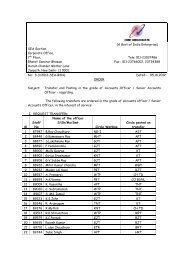


![FORM 'F' [See sub-rule (1) of rule 6] Nomination To ...](https://img.yumpu.com/49209238/1/190x245/form-f-see-sub-rule-1-of-rule-6-nomination-to-.jpg?quality=85)
